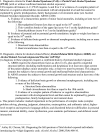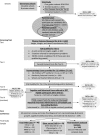Prevalence and characteristics of fetal alcohol spectrum disorders
- PMID: 25349310
- PMCID: PMC4210790
- DOI: 10.1542/peds.2013-3319
Prevalence and characteristics of fetal alcohol spectrum disorders
Abstract
Objectives: To determine the prevalence and characteristics of fetal alcohol spectrum disorders (FASD) among first grade students (6- to 7-year-olds) in a representative Midwestern US community.
Methods: From a consented sample of 70.5% of all first graders enrolled in public and private schools, an oversample of small children (≤ 25th percentile on height, weight, and head circumference) and randomly selected control candidates were examined for physical growth, development, dysmorphology, cognition, and behavior. The children's mothers were interviewed for maternal risk.
Results: Total dysmorphology scores differentiate significantly fetal alcohol syndrome (FAS) and partial FAS (PFAS) from one another and from unexposed controls. Alcohol-related neurodevelopmental disorder (ARND) is not as clearly differentiated from controls. Children who had FASD performed, on average, significantly worse on 7 cognitive and behavioral tests and measures. The most predictive maternal risk variables in this community are late recognition of pregnancy, quantity of alcoholic drinks consumed 3 months before pregnancy, and quantity of drinking reported for the index child's father. From the final multidisciplinary case findings, 3 techniques were used to estimate prevalence. FAS in this community likely ranges from 6 to 9 per 1000 children (midpoint, 7.5), PFAS from 11 to 17 per 1000 children (midpoint, 14), and the total rate of FASD is estimated at 24 to 48 per 1000 children, or 2.4% to 4.8% (midpoint, 3.6%).
Conclusions: Children who have FASD are more prevalent among first graders in this Midwestern city than predicted by previous, popular estimates.
Keywords: alcohol use and abuse; children with FASD; fetal alcohol spectrum disorders; prenatal alcohol use; prevalence; women.
Copyright © 2014 by the American Academy of Pediatrics.
Figures





Similar articles
-
The prevalence of fetal alcohol spectrum disorders in rural communities in South Africa: A third regional sample of child characteristics and maternal risk factors.Alcohol Clin Exp Res. 2022 Oct;46(10):1819-1836. doi: 10.1111/acer.14922. Epub 2022 Sep 1. Alcohol Clin Exp Res. 2022. PMID: 35971629 Free PMC article.
-
Fetal Alcohol Spectrum Disorders in a Midwestern City: Child Characteristics, Maternal Risk Traits, and Prevalence.Alcohol Clin Exp Res. 2020 Apr;44(4):919-938. doi: 10.1111/acer.14314. Epub 2020 Apr 15. Alcohol Clin Exp Res. 2020. PMID: 32293735 Free PMC article.
-
Epidemiology of FASD in a province in Italy: Prevalence and characteristics of children in a random sample of schools.Alcohol Clin Exp Res. 2006 Sep;30(9):1562-75. doi: 10.1111/j.1530-0277.2006.00188.x. Alcohol Clin Exp Res. 2006. PMID: 16930219
-
Maternal risk factors for fetal alcohol spectrum disorders: not as simple as it might seem.Alcohol Res Health. 2011;34(1):15-26. Alcohol Res Health. 2011. PMID: 23580036 Free PMC article. Review.
-
Italian Guidelines for the diagnosis and treatment of Fetal Alcohol Spectrum Disorders: structural abnormalities.Riv Psichiatr. 2024 Sep-Oct;59(5):221-229. doi: 10.1708/4360.43512. Riv Psichiatr. 2024. PMID: 39470674 Review. English.
Cited by
-
Multifactorial Genetic and Environmental Hedgehog Pathway Disruption Sensitizes Embryos to Alcohol-Induced Craniofacial Defects.Alcohol Clin Exp Res. 2020 Oct;44(10):1988-1996. doi: 10.1111/acer.14427. Epub 2020 Aug 30. Alcohol Clin Exp Res. 2020. PMID: 32767777 Free PMC article.
-
The gestational foundation of sex differences in development and vulnerability.Neuroscience. 2017 Feb 7;342:4-20. doi: 10.1016/j.neuroscience.2015.07.068. Epub 2015 Jul 29. Neuroscience. 2017. PMID: 26232714 Free PMC article. Review.
-
Alcohol Use in Pregnancy.Clin Obstet Gynecol. 2019 Mar;62(1):142-155. doi: 10.1097/GRF.0000000000000414. Clin Obstet Gynecol. 2019. PMID: 30575614 Free PMC article. Review.
-
The prevalence of fetal alcohol spectrum disorders in rural communities in South Africa: A third regional sample of child characteristics and maternal risk factors.Alcohol Clin Exp Res. 2022 Oct;46(10):1819-1836. doi: 10.1111/acer.14922. Epub 2022 Sep 1. Alcohol Clin Exp Res. 2022. PMID: 35971629 Free PMC article.
-
Animal models of gene-alcohol interactions.Birth Defects Res. 2020 Mar 1;112(4):367-379. doi: 10.1002/bdr2.1623. Epub 2019 Nov 27. Birth Defects Res. 2020. PMID: 31774246 Free PMC article. Review.
References
-
- Jones KL, Smith DW. Recognition of the fetal alcohol syndrome in early infancy. Lancet. 1973;302(7836):999–1001 - PubMed
-
- May PA, Hymbaugh KJ, Aase JM, Samet JM. Epidemiology of fetal alcohol syndrome among American Indians of the Southwest. Soc Biol. 1983;30(4):374–387 - PubMed
-
- May PA, Gossage JP, Kalberg WO, et al. . Prevalence and epidemiologic characteristics of FASD from various research methods with an emphasis on recent in-school studies. Dev Disabil Res Rev. 2009;15(3):176–192 - PubMed
Publication types
MeSH terms
Grants and funding
LinkOut - more resources
Full Text Sources
Other Literature Sources
Medical
Research Materials
Miscellaneous

